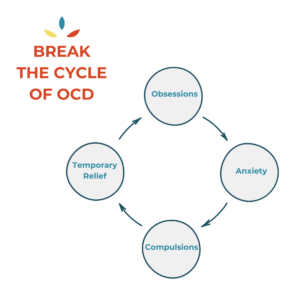Obsessive Compulsive Disorder (OCD) in adults and children is more common than you might think.
In the United States, about 1 in 100 adults and at least 1 in 200 kids and teens have OCD. [1] [2]
How do you know if you or a loved one may be experiencing OCD?
Individuals with OCD typically experience both obsessions and compulsions.
Obsessions are where the brain fires off uncontrollable, terrifying, intrusive thoughts that can be crippling. For example, fear of being contaminated, doubts that you’ve locked the door or turned off the stove, images of harming people, unpleasant sexual images, and intense fears in relationships.
When someone has OCD it’s like their brain doesn’t have a strong antivirus software. Obsessions are like a virus attack with pop-up ads that just keep coming! The thoughts are persistent and they have trouble clicking out of them. This overwhelming experience floods the individual with anxiety, causing them to, ultimately, feel driven to do compulsive acts to ease the stress.
Compulsions can include:
- Hand-washing until your skin becomes raw.
- Checking doors over and over again to make sure they’re locked.
- Counting in certain patterns.
- Silently repeating a prayer, word, or phrase.
- Avoiding driving or being around certain people.
- Trying to replace a bad thought with a good thought.
- Seeking reassurance repeatedly in relationships.
These compulsions can temporarily relieve anxiety, but the obsessions eventually resurface, and the vicious cycle starts all over again. This cycle often leaves loved ones feeling confused and bewildered. And individuals who are struggling with these symptoms first-hand may have difficulty articulating what is going on and explaining how they are feeling.
How to Break the Cycle

Mental healthcare is not “one size fits all.” OCD is complex, and it takes specialized training and expertise to diagnose and treat it.
Exposure and Response Prevention (ERP) is an evidence-based treatment that is known as the gold-standard treatment for anxiety disorders and obsessive-compulsive disorder (OCD). It has been shown to be effective in 80% of people who suffer from OCD, providing significant results in as little as 12-20 sessions.[1] In ERP treatment, you’ll target anxiety through the process of engaging in gradual and repeated exposure to anxiety triggers while concurrently reducing reliance on safety behaviors, methods of avoidance, and compulsions (Response Prevention).
This cycle can be broken, and long-term relief can be achieved. We’ll work closely to help you to create a roadmap that will help you better understand your mental health, increase your feelings of empowerment, and arm you with the tools to effectively combat your anxiety and reclaim your life.
Put an end to your anxiety cycle by contacting ThrivePointe to begin your therapeutic journey towards mental wellness today.
[1] https://www.treatmyocd.com/blog/how-long-does-ocd-treatment-take
[2] National Institute of Mental Health
[3] Ruscio AM, Stein DJ, Chiu WT, Kessler RC. “The epidemiology of obsessive-compulsive disorder in the National Comorbidity Survey Replication.” Molecular Psychiatry. 2008 Aug 26.
OCD & Anxiety Treatment in Indianapolis
Get support from a therapist specializing in OCD and Anxiety in Indianapolis & Greenwood, IN

